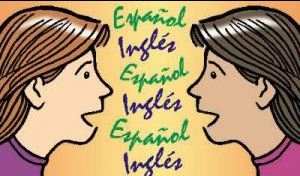Why Do Children Code-Switch
By: Ellen Stubbe Kester and Alejandro Brice

There has been a lot of recent attention to the topic of code-switching. Code-switching is defined as a switch from one language to another in a single discourse. It is often misunderstood as a bilingual’s lack of understanding of either language. However, both early and recent research suggest that code-switching is used for a variety of functions, is rule-based, and is indicative of sociolinguistic competency.
Code-switching is a natural part of being bilingual, allowing bilinguals to draw on their resources of both linguistic codes at once (Palmer, 2009). Palmer’s research encourages teachers to allow conversational code-switches, yet set expectations for students to produce monolingual spoken and written texts where appropriate. In a study with 4-to-6-year-old bilingual children, Vu and colleagues (Vu, Bailey, & Howes, 2010), found that many instances of code-switching were sociopragmatic in nature. For example, they found that children code-switched to try to gain the interviewer’s attention or to change speaking roles. This suggests that these young children have the facility to use their two languages strategically for both linguistic and nonlinguistic purposes from a very early age. This is consistent with findings by Reyes (2004) that immigrant Spanish-speaking children, ages 7- to 10-years, employed switches that were more frequent and were deployed for a wider variety of functions than the younger children’s. The results challenge the negative view that code switching by children who are learning two languages is due to lack of proficiency, and instead support the view that it is used as a strategy to extend their communicative competence during peer interaction (Reyes, 2004).
Menendez (2010) has indicated that these positive attitudes towards language interaction in the realm of bilingualism open new horizons for sign bilingual education, indicating that “cross-modal bilingualism in the Deaf community is a “natural, dynamic phenomenon,” where code mixing and code switching between languages of different modalities–signed or spoken/written–are often a pragmatic choice of the signer/speaker that serves specific purposes in specific contexts.” This use of languages can be viewed as a sign of sophistication, as in any bilingualism, and a fundamental, transitory phase of bilingual language acquisition (Menendez, 2010).
The Structure of Code-Switching
Vu and colleagues (2010) found that most code-switches took the form of single-word borrowings.
Ganishi (1975) found that 4 to 6-year olds consistently applied the situational rule that they speak the language their listener knew best.
Smith (2009) found that there is a higher frequency of Spanish sentences containing English words than English sentences containing Spanish words. But the reverse is true of grammatical influence without mixing words. There is a higher frequency of English influenced grammatically by Spanish than Spanish influenced grammatically by English. This asymmetry of the two languages may be due to the asymmetrical status of each language in the social setting (Smith, 2009).
\References
Genishi, C. S., (1976). Rules for Code-Switching in Young Spanish-English Speakers: An Exploratory Study of Language Socialization. Dissertation.
Menendez, B. (2010). Cross-Modal Bilingualism: Language Contact as Evidence of Linguistic Transfer in Sign Bilingual Education. International Journal of Bilingual Education and Bilingualism, v13, n2 p201-223
Palmer, D. K. (2009). Code-Switching and Symbolic Power in a Second-Grade Two-Way Classroom: A Teacher’s Motivation System Gone Awry. Bilingual Research Journal, v32 n1 p42-59.
Reyes, I. (2004). Functions of Code Switching in Schoolchildren’s Conversations. Bilingual Research Journal, v28 n1 p77-98.
(Smith, D. J., (2009). Asymmetrical Mixing Patterns of Spanish and English in a New Immigrant Community. Bilingual Research Journal, v32 n2 p188-206
Vu, J. A., Bailey, A. L., Howes, C. (2010). Early Cases of Code-Switching in Mexican-Heritage Children: Linguistic and Sociopragmatic. Bilingual Research Journal, v33 n2 p200-219.
This Month’s Featured Authors:
Ellen Kester, Ph.D., CCC-SLP Bilinguistics, Inc.
Alejandro Brice, Ph.D., CCC-SLP University of South Florida St. Petersburg
Dr. Ellen Kester is a Founder and President of Bilinquistics, Inc. http://www.bilinguistics.com. She earned her Ph.D. in Communication Sciences and Disorders from The University of Texas at Austin. She earned her Master’s degree in Speech-Language Pathology and her Bachelor’s degree in Spanish at The University of Texas at Austin. She has provided bilingual Spanish/English speech-language services in schools, hospitals, and early intervention settings. Her research focus is on the acquisition of semantic language skills in bilingual children, with emphasis on assessment practices for the bilingual population. She has performed workshops and training seminars, and has presented at conferences both nationally and internationally. Dr. Kester teaches courses in language development, assessment and intervention of language disorders, early childhood intervention, and measurement at The University of Texas at Austin. She can be reached at
[email protected]
Dr. Alejandro E. Brice is an Associate Professor at the University of South Florida St. Petersburg in Secondary/ESOL Education. His research has focused on issues of transference or interference between two languages in the areas of phonetics, phonology, semantics, and pragmatics related to speech-language pathology. In addition, his clinical expertise relates to the appropriate assessment and treatment of Spanish-English speaking students and clients. Please visit his website at http://scholar.google.com/citations?user=LkQG42oAAAAJ&hl=en or reach him by email at [email protected]
PediaStaff is Hiring!
All JobsPediaStaff hires pediatric and school-based professionals nationwide for contract assignments of 2 to 12 months. We also help clinics, hospitals, schools, and home health agencies to find and hire these professionals directly. We work with Speech-Language Pathologists, Occupational and Physical Therapists, School Psychologists, and others in pediatric therapy and education.
